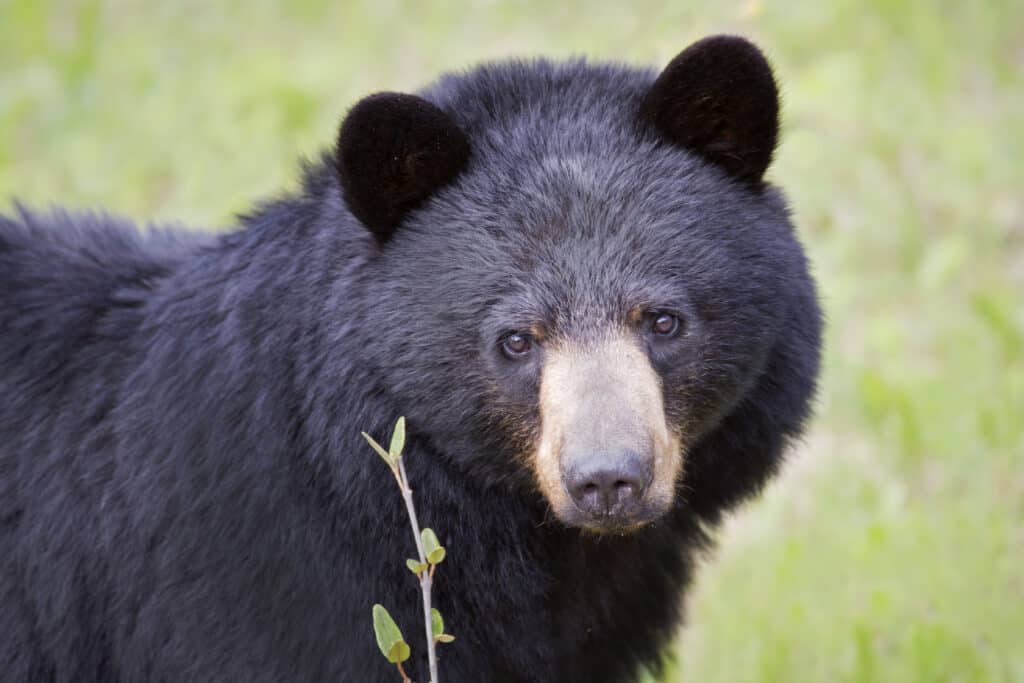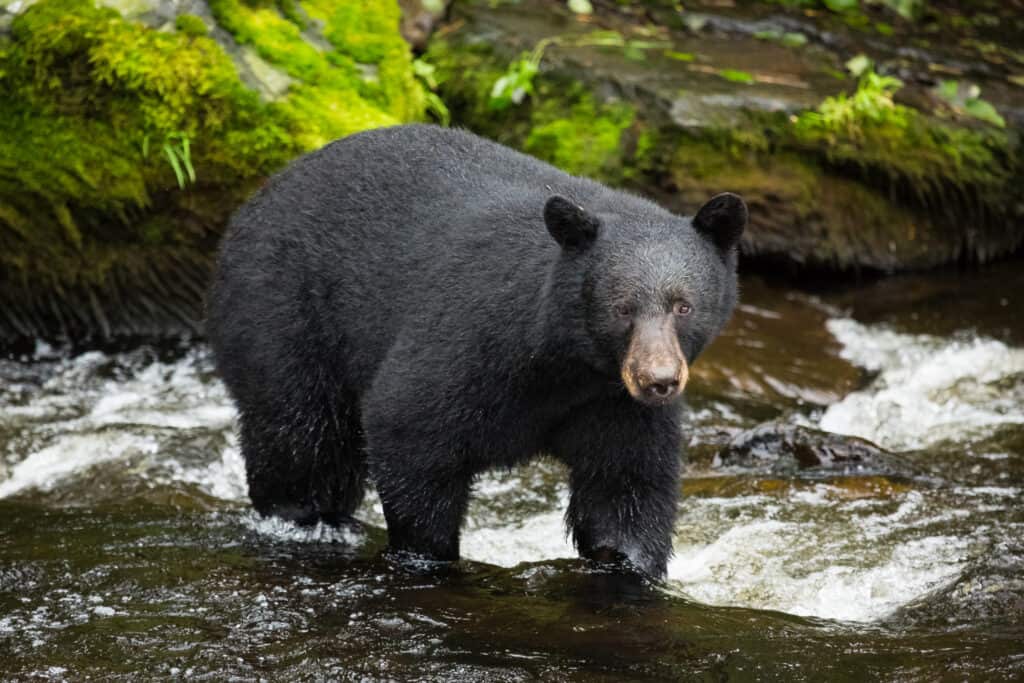Located in the Midwestern region of the United States, Missouri has a rich cultural history. Humans have lived in Missouri for at least 12,000 years, and the state played an important role as a staging area during westward expansion in the 19th century. The state also boasts incredible natural beauty. The mighty Missouri River – from which Missouri gets its name – flows through the state’s center. The northern part of the state features rolling hills dotted with sinkholes and caves. Meanwhile, the warm, wet, flat southern half of the state possesses fertile soil perfect for agriculture and hardwood forests and woodlands.
Many animals make their home in Missouri. Some of its official state animals include the mule, channel catfish, western honeybee, and American bullfrog. You can even find bears in Missouri. While bears almost completely disappeared from Missouri in the 20th century, the population is slowly making a comeback. Keep reading to learn more about the largest bear ever caught in Missouri!
The Largest Bear Ever Caught in Missouri

In Missouri, the largest bear ever caught is not particularly known.
©Wild Art/Shutterstock.com
The largest bear ever caught in Missouri is a conversation that will likely never be fully answered. The first Europeans arrived in present-day Missouri in 1673. Prior to then, numerous Native American tribes lived in the states. While the people of these tribes occasionally hunted black bears, their hunting did not overly impact bear numbers. Before settlers arrived in Missouri, the state’s population of black bear population likely numbered in the thousands or tens of thousands. All that changed once settlers arrived in droves during the early 19th century.
Around 1811, entrepreneurs quickly realized they could make a quick buck selling bear oil and other parts. Within about 80 years, hunters wiped out most bears in the state. Logging and timber clearing for homesteading also eliminated most of the bears’ natural habitat. The few bears that remained fled to the southern part of the state to scrape out a living in Missouri’s remote swamplands. Few records exist from the 19th century that record the size of bears killed during that time. Therefore, the largest bear ever caught in Missouri could very well have been killed over a hundred years ago, but we’ll never know.
In recent years, the largest bear killed in Missouri died in a traffic collision with a semi-trailer in 2014. On November 10th, 2014, an 18-wheeler collided with a 600-pound American black bear on Highway 63 near Thayer, Missouri. In the early hours of the morning, the massive bear walked into the semi-trailer as it was driving along the highway. The bear weighed so much that the Missouri Department of Transportation needed a log chain to pull the bear off the road. Thus ended the life of one of the largest bears caught in Missouri in recent memory.
Bears in Missouri: Types and Appearance
The only bears historically found in Missouri are American black bears (Ursus americanus). Grizzly bears (Ursus arctos) and polar bears (Ursus maritimus) cannot survive in the swampy, warm, and wet Missouri landscape.
The black bears found in Missouri range in weight and length depending on their sex, age, and the time of year. Generally, older bears measure larger than juveniles, and males measure larger than females. Additionally, bears tend to put on weight in the summer and fall for the winter and usually weigh the most in late fall. With this in mind, adult black bears range from 90 to 500 pounds. However, as the above example demonstrates, large specimens can weigh up to 700 pounds. Most black bears in Missouri weigh on the smaller side, between 200 and 250 pounds. On average, black bears measure 3 to 5 feet long, but when standing on their hind legs, they can exceed 7 feet tall.
A black bear’s thick coat usually looks black, hence its name. That said, some black bears vary in color from dark brown to blonde to cinnamon to blue-gray. The muzzle typically appears brown, and many bears usually sport a white patch on the chest. They possess long, sharp claws suitable for climbing trees and rounded erect ears.
Bears in Missouri: Habitat
The American black bear is North America’s most widely distributed bear species. You can find black bears throughout most of the continent in a wide range of habitats. However, most black bears tend to live in colder climates with small human populations. The densest concentrations live in the western and northern United States, Alaska, and Canada. However, you can find smaller populations in the American south and parts of Mexico. Black bears favor habitats with plenty of trees for them to climb and den inside during winter. As such, they prefer to live in mixed and coniferous forests and woodlands. Despite this preference, you can find them in various habitats, including shrublands, mountainous zones, wetlands, and riparian zones.
In Missouri, most black bears live south of the Missouri River. While you can occasionally find bears in the northern half of the state, sightings rarely occur in that region. During the late 19th and early 20th centuries, black bears almost exclusively lived in the swamps and wetlands of the Missouri Bootheel in the southeastern corner of the state. However, this started to change in the mid-20th century after neighboring Arkansas started to reintroduce bears to the state. Over time, these bears wandered into Missouri and spread out into what territory they could find. Today, most bear sightings occur along hiking trails or near highways.
How Many Bears Are There in Missouri?

Missouri hosts approximately 800 to 1,000 American black bears.
©SCStock/Shutterstock.com
Currently, Missouri hosts approximately 800 to 1,000 American black bears. According to some Missouri Department of Conservation biologists, the state’s black bear population is set to grow at around 9% annually. However, other experts dispute that claim, saying the true growth rate could be much lower. Furthermore, due to the recent killings of bears in organized hunts and traffic collisions, the state’s total population of bears may be lower than originally thought. By some estimates, the state’s population could equal approximately 500 to 800 bears. No one can say for sure, given the difficulty in tagging and tracking individual bears. Prior to the early 19th century, you could find black bears throughout Missouri. At that time, the black bear population in the state likely numbered in the thousands or tens of thousands, but no one can say for sure.
Presently, the total North American black bear population numbers around 800,000. Although black bears rarely occur in Missouri, they enjoy a widespread distribution and population throughout the continent. As a result, the IUCN lists American black bears as a species of Least Concern.
Is It Legal to Hunt Bears in Missouri?
No laws existed restricting the hunting of bears in Missouri prior to the mid-20th century. The extirpation of bears throughout the state prompted authorities to regulate bear hunting tightly. Even after bears started to reappear in the mid-20th century, Missouri forbade bear hunting until recently. Missouri only legalized hunting bears in the state starting in 2021. Currently, Missouri restricts bear hunting to three zones south of the Missouri River, known as Bear Management Zones.
Within these Bear Management Zones, hunters with a license can hunt bears during designated harvest seasons. Hunters are limited to one bear per harvest season, and only lone bears can be harvested (no mothers with cubs). Additionally, you cannot harvest a bear while it is in its den or in a stream or body of water. Missouri randomly issues several hundred permits each year to hunters who pay $10 to get a chance for a coveted permit. In 2021, Missouri issued 400 permits to approximately 6,000 applicants. Missouri prohibits the use of the following when bear hunting:
- Fully automatic hunting firearms
- Self-loading firearms with more than 11 cartridges in a magazine and chamber combined
- Ammunition propelling more than one projectile at a single discharge (buckshot)
- Dogs
- Bait
- Electronic calls
- Artificial light, night vision equipment, thermal imagery equipment, or telemetry equipment
- Hunting from a motor-driven boat, aircraft, or land vehicle
Are Bears Dangerous?
It should go without saying that almost any wild animal can pose a danger to humans. This rule of thumb especially holds true for large land carnivores such as bears. Although they rank as the smallest bears in North America, black bears can still seriously harm or kill people. Adult black bears can grow up to 700 pounds or more and stand 7 feet tall. Pound-for-pound bears are approximately 5 times stronger than the average human. Even a relatively small black bear can easily overpower an exceptionally stronger person. If you then take into account their long claws and powerful jaws, you see why people consider wild black bears dangerous. That said, your chances of getting attacked by a black bear in Missouri are incredibly low. In the United States, black bears kill, on average 1 person per year. The chances of you getting killed by a deer or a dog are far greater than the chance of a bear killing you.
In the event that you encounter a black bear in the wild, you should attempt to remain calm. Whatever you do, avoid running away from a black bear, as this may trigger the bear’s chase instinct. Stand up tall and wave your arms above your head to make yourself appear as large as possible. Back away from the bear while maintaining eye contact. Speak in calm, reassuring tones toward the bear to let them know you’re there. If the bear moves towards you, raise your voice while continuing to back away. Put on a backpack or heavy coat if you have one with you for added protection. Finally, prepare to defend yourself with all your strength as a last resort. To avoid such encounters, always bring bear mace with you if you plan to go hiking in areas where bears frequent.
Conclusion
No one knows for sure which bear holds the record of the largest bear ever caught in Missouri. More and more bear sightings occur every year as the bear population in Missouri continues to grow. Although only 800 to 1,000 bears currently reside in Missouri, advocates hope that number to double by 2030. If that happens, especially large bears may become more common in the Show Me State.
Up Next:
- Discover the 10 Largest Bears in the World
- Discover the 4,000lb Bear That Was The Largest Ever
- Discover the Largest Bear Ever Caught in Oregon
- Discover the Largest Bear Ever Caught in Michigan
- Discover the Largest Brown Bear Ever
The photo featured at the top of this post is © iStock.com/Mark Lee
Sources
- , Available here: https://www.foxnews.com/us/trucker-kills-600-pound-bear-in-southern-missouri
- , Available here: https://www.kbsi23.com/news/8-black-bears-taken-in-missouris-2022-bear-hunting-season/#:~:text=Bear%20hunting%20in%20Missouri%20is%20limited%20to%20Missouri,to%20public%20or%20private%20property%20within%20the%20BMZ.
- , Available here: https://mdc.mo.gov/hunting-trapping/regulations/bear-hunting-regulations
Thank you for reading! Have some feedback for us? Contact the AZ Animals editorial team.






